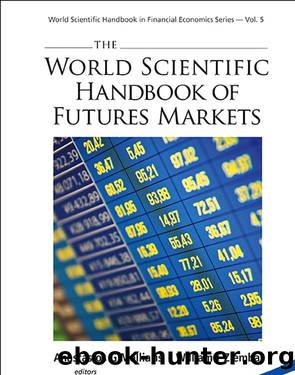World Scientific Handbook of Futures Markets by Anastasios G Malliaris William T Ziemba

Author:Anastasios G Malliaris, William T Ziemba
Language: eng
Format: epub
Publisher: World Scientific Publishing Co. Pte. Ltd.
*All examples in this report are hypothetical interpretations of situations and are used for explanation purposes only. The views in this report reflect solely those of the author and not necessarily those of CME Group or its affiliated institutions. This report and the information herein should not be considered as investment advice or the results of actual market experience.
1Bureau of Economic Analysis, U.S. Department of Commerce, www.BEA.gov.
2U.S. Treasury Department, www.treasurydirect.gov/NP/debt/current.
3See CME Group’s web site for contract details and specifications at www.cmegroup.com/trading/interest-rates.
4For a full text on risk management tools, including financial futures products, see The CME Group Risk Management Handbook: Products and Applications, authored by John W. Labuszewski, John E. Nyhoff, Richard Co and Paul E. Peterson, published by John Wiley, 2010.
5At the risk of overcomplicating this description, all of a defaulting clearing member’s Performance Bond and Guarantee Fund assets across all waterfalls are eligible to be liquidated in the event of a default. CME Clearing will declare default in one Guarantee Fund as default in all and liquidate all clearing member assets accordingly. At the mutualized level of the financial safeguards waterfall the Guarantee Funds are siloed in terms of the three classes of activity — IRS, CDS and Base products (standard exchange-traded futures and options).
6See CME Rules 802.G, 8G802.G and 8H802.G, for greater detail of assessment powers for the three default waterfalls maintained by CME.
7See “Markets for CCPs and Regulation: Considering Unintended Consequences”, by Serge Wibaut and D. Sykes Wilford, Journal 34: Cass-Capco Institute Paper Series on Risk, 2012.
8For an illustrated and comprehensive review of the history of CME Group, see Past, Present, and Futures: Chicago Mercantile Exchange, by Jeffrey L. Rodengen, Write Stuff Enterprises, 2008.
9“The Need for Futures Markets in Currencies” originally was written by Professor Milton Friedman in December 1971, and has been re-published in the Cato Journal, Volume 31, Number 3, Fall 2011, pp. 635–642.
10See For Crying Out Loud: From Open Outcry to the Electronic Screen, by Leo Melamed, published by John Wiley & Sons, 2009.
11See “How and When do Markets Tip? Lessons from the Battle of the Bund”, Estelle Cantillon and Pai-Ling Yin, published by the European Central Bank, Working Paper Series, Number 766, June 2007. The story of how the DTB was able to take the German bond futures product away from the LIFFE is a fascinating case study. DTB was an electronic exchange. It decided to offer a product identical to that on LIFFE for the German 10-year Government Bond or the Bund contract as it is known. The DTB used its superior technology, financial trading incentives, and had some help from German financial institutions moving their business. In the second half of 1997 and early 1998, the DTB effectively garnered about 90% of the trading. Prior to the competitive battle, the Bund product represented about one-third of trading revenue for LIFFE. LIFFE turned a nice profit in 1997, only to see even larger losses in 1998 after losing the battle of the Bund, sending a powerful message to every other futures exchange
Download
This site does not store any files on its server. We only index and link to content provided by other sites. Please contact the content providers to delete copyright contents if any and email us, we'll remove relevant links or contents immediately.
Hit Refresh by Satya Nadella(8338)
The Compound Effect by Darren Hardy(7562)
Change Your Questions, Change Your Life by Marilee Adams(6641)
Nudge - Improving Decisions about Health, Wealth, and Happiness by Thaler Sunstein(6634)
The Black Swan by Nassim Nicholas Taleb(6192)
Daring Greatly by Brene Brown(5643)
Deep Work by Cal Newport(5471)
Principles: Life and Work by Ray Dalio(5323)
Rich Dad Poor Dad by Robert T. Kiyosaki(5150)
The Myth of the Strong Leader by Archie Brown(4789)
Man-made Catastrophes and Risk Information Concealment by Dmitry Chernov & Didier Sornette(4738)
Big Magic: Creative Living Beyond Fear by Elizabeth Gilbert(4723)
The Slight Edge by Jeff Olson(4722)
Discipline Equals Freedom by Jocko Willink(4638)
Digital Minimalism by Cal Newport;(4545)
The Motivation Myth by Jeff Haden(4528)
Stone's Rules by Roger Stone(4417)
Management Strategies for the Cloud Revolution: How Cloud Computing Is Transforming Business and Why You Can't Afford to Be Left Behind by Charles Babcock(4131)
The Doodle Revolution by Sunni Brown(4044)
